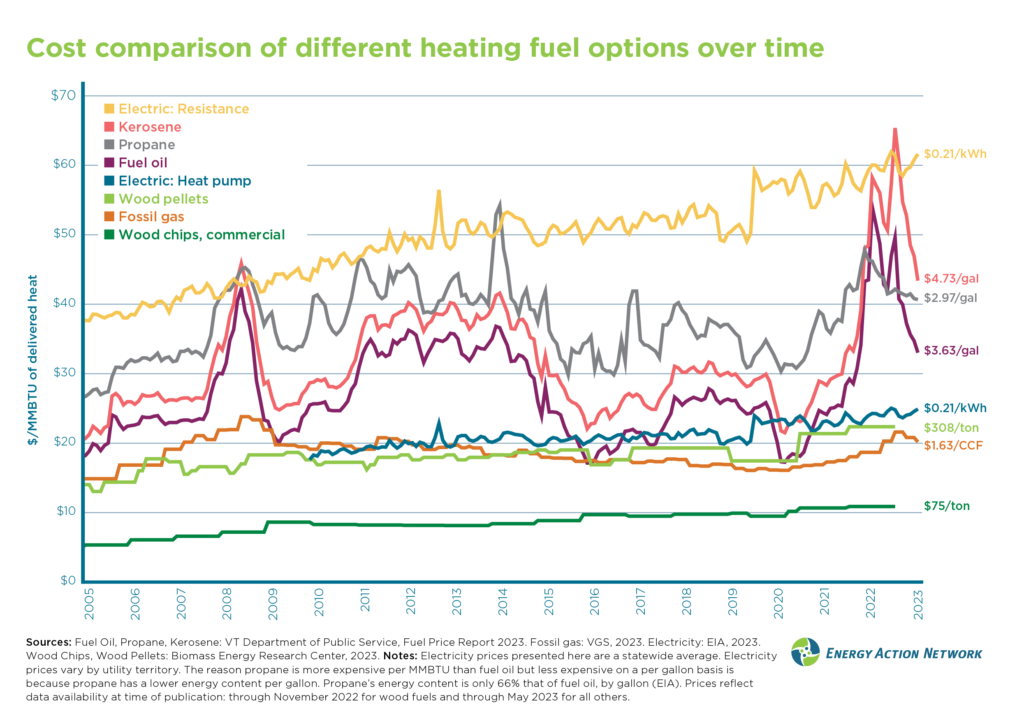
Below are responses from the Clean Heat Working group to a number of Frequently Asked Questions. You can also download or print a pdf of this FAQ here.
Note: All Affordable Heat Act/ S.5 bill references are to the version passed by the House and Senate on April 27, 2023.
Last updated May 10, 2023.
Affordable Heat Act is designed to help Vermonters reduce their dependence on high-cost, price-volatile, and polluting fossil heating fuels. Generally speaking, the most expensive heat is fossil heat and the most affordable, price-stable heat is clean heat. That is why, by 2030, the clean heat services that could result from the Act are estimated to reduce the overall heating costs of Vermonters by $2 billion, or an average of $7,500 per household. [1]
The Act does this by establishing a Clean Heat Standard that will require importers of fossil heating fuels into Vermont to reduce pollution over time, in line with Global Warming Solutions Act requirements. To do so, fossil fuel importers will have to deliver or pay for cleaner heat options — mostly for lower and middle income Vermonters — and especially with solutions that cut costs over time, like weatherization, heat pumps, and advanced wood heat.

Generally speaking, the most expensive heat is fossil heat (especially kerosene, fuel oil, and propane) and the most affordable, price-stable heat is clean heat (especially the heat you don’t use as a result of weatherization, plus heat pumps and advanced wood heat). That is why, by 2030, the clean heat services that could result from the Act are estimated to reduce the overall heating costs of Vermonters by $2 billion, or an average of $7,500 per household. The cost of heating oil—which more Vermonters rely on to heat their homes than any other fuel—was at a near-record high of $5.48 a gallon in November of 2022. The impact of this price spike, comparing November 2022 prices to November 2021 prices ($3.13), for a household that uses 1,000 gallons a year amounts to an annual heating bill increase of over $2,000. This is not sustainable.
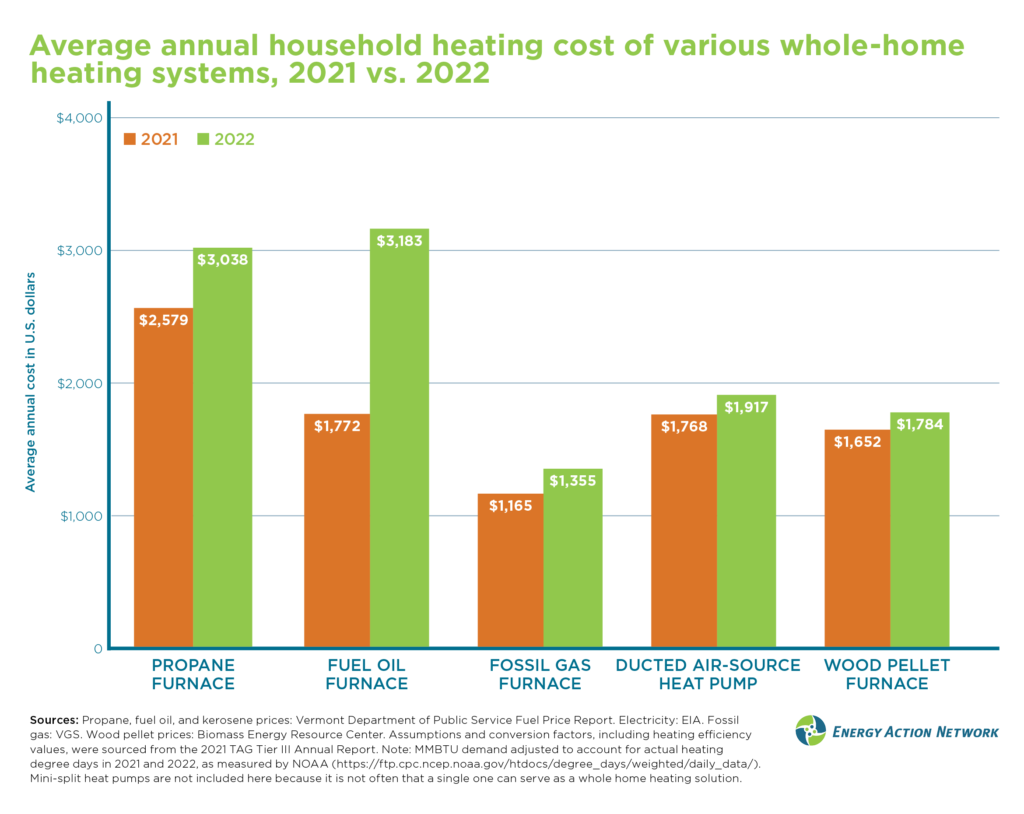 The high costs and price volatility of fossil fuels have been especially pronounced recently but are consistent features of 100% imported commodity fossil fuels. The burden of these costs are especially high for lower-income and moderate-income Vermonters. To work toward a more affordable Vermont, we can’t continue to leave Vermonters – especially lower and middle income Vermonters – exposed to and dependent on these high cost, price-volatile fossil fuels. The only way to effectively cut energy cost burdens is to reduce exposure to fossil fuels and help Vermonters shift to lower-cost, more price-stable, and more efficient clean heating options. To take just one example, combining the up-front cost of equipment with the annual fuel or electricity it consumes, over a twelve year period it costs the average household less than $500 a year to use a heat pump water heater. The cost to use a propane water heater? More than twice as much, at about $1,000 a year.
The high costs and price volatility of fossil fuels have been especially pronounced recently but are consistent features of 100% imported commodity fossil fuels. The burden of these costs are especially high for lower-income and moderate-income Vermonters. To work toward a more affordable Vermont, we can’t continue to leave Vermonters – especially lower and middle income Vermonters – exposed to and dependent on these high cost, price-volatile fossil fuels. The only way to effectively cut energy cost burdens is to reduce exposure to fossil fuels and help Vermonters shift to lower-cost, more price-stable, and more efficient clean heating options. To take just one example, combining the up-front cost of equipment with the annual fuel or electricity it consumes, over a twelve year period it costs the average household less than $500 a year to use a heat pump water heater. The cost to use a propane water heater? More than twice as much, at about $1,000 a year.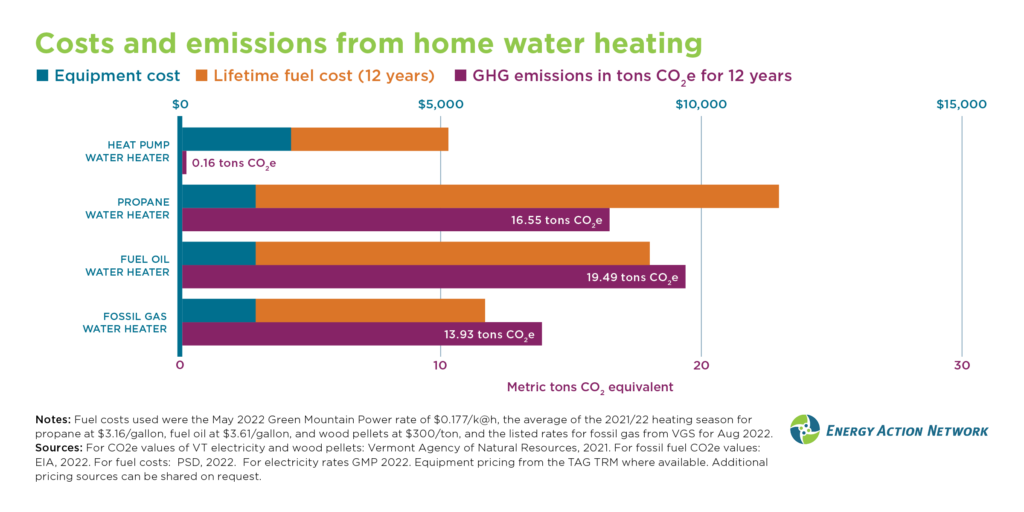
Whether an individual household saves money or not will depend on the choices they make. Those who take advantage of the expanded weatherization services and cleaner heat options that will result from this policy will almost certainly see their bills go down. Those who decide to continue depending on fossil fuels will continue to be exposed to the higher costs and price volatility that have been a feature of the 100% imported commodity fossil fuel market for decades.
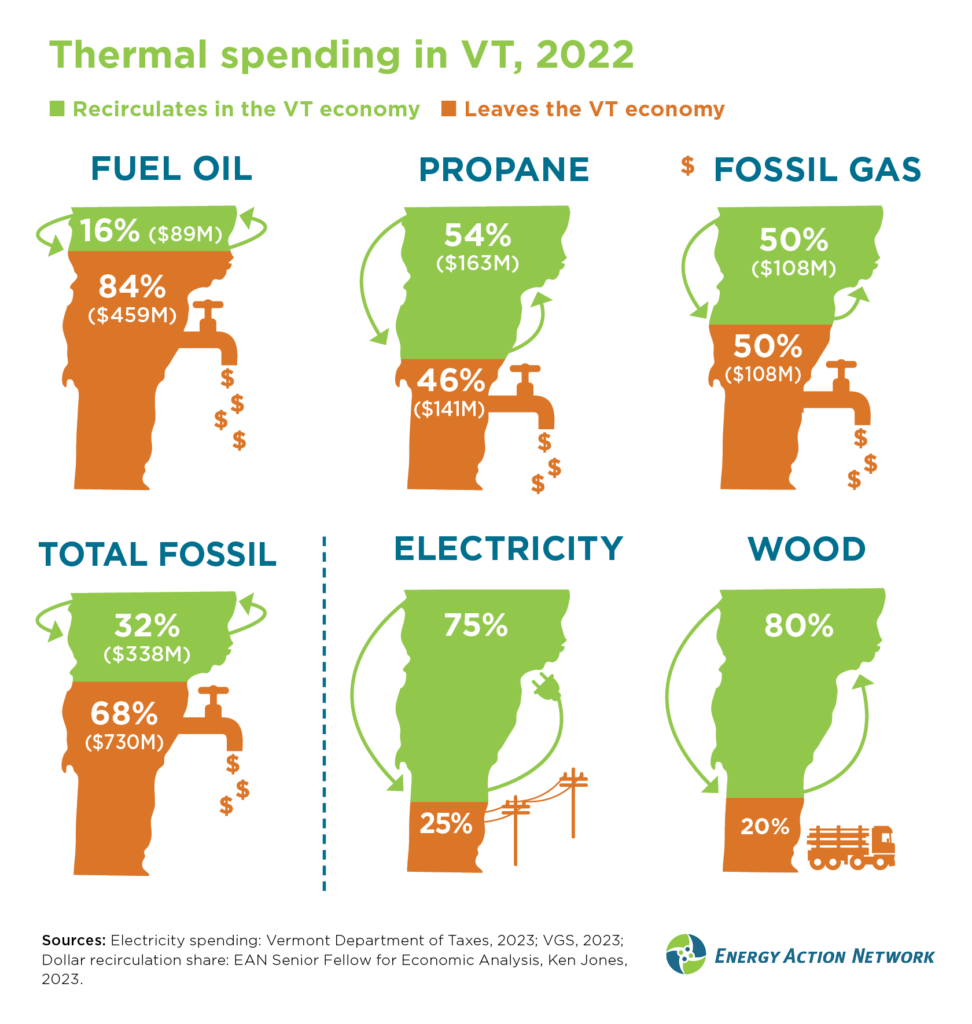
Financially speaking, the Vermonters who will benefit the most will be those who take advantage of more affordable, cleaner heating options that the Affordable Heat Act will make more available and affordable, especially for lower- and middle-income Vermonters who are required to be served in the greatest numbers. And all Vermonters and future generations will benefit from reduced pollution and early adoption of more price stable energy systems. Additionally, the s tate economy will benefit as we move from 100% imported fossil fuels toward energy options that keep more dollars in-state and do more to contribute to local jobs and the Vermont economy.
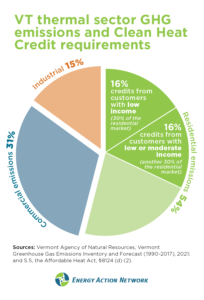
The Affordable Heat Act requires that the majority of clean heat services in the residential sector go to lower- and middle-income Vermonters. It also requires that no less than half of heating services that lower- and middle-income Vermont households
receive be “installed measures” that reduce heating costs over time, such as weatherization, heat pumps, and advanced wood heat. This Act has been carefully designed to center and advance energy equity, prioritizing cost-saving benefits for lower and middle-income Vermonters in a progressive way.
The Affordable Heat Act will result in more clean heat options becoming available to Vermonters at lower cost – everything from weatherization to heat pumps and heat pump water heaters to advanced wood heating options to biofuels (though only those biofuels that are lower emitting on a lifecycle basis than fossil fuels and that are eligible under the program’s carbon intensity threshold).
In order to comply with the Affordable Heat Act, importers of fossil fuel will have to purchase and retire clean heat credits, the value of which is directly proportional to the amount of emissions reduction achieved. In order to acquire clean heat credits, fossil fuel importers will have to pay for them. This means that Vermonters – especially lower and middle income Vermonters – will get increased incentives to do things that reduce pollution (i.e., lower cost weatherization, more heavily incentivized heat pumps and heat pump water heaters, etc.), paid for by fossil fuel importers (those fossil fuel importers, in turn, will likely pass some of that cost on to their fossil fuel customers). At the same time, fossil fuel importers will also have a powerful incentive to uncover and deliver the lowest cost means of reducing climate pollution. And the prices of lower emitting fuels, such as qualifying forms of B100 biodiesel, are expected to decline in price.
Scenario A: The Anderson family is a lower-income family that lives in an apartment. They pay the utilities for the apartment but the property owner is responsible for the appliances. The propane water heater that heats their water dies. Instead of replacing it with another propane water heater, the property owner takes advantage of a clean heat credit supported incentive that lowers the upfront cost to install a new heat pump water heater to below the cost of installing a new propane water heater. This allows the Anderson family to save nearly $500 a year.

Scenario B: The Bertrand family is a middle-income family. They live in an average size home and heat with a fuel oil furnace. They make too much to qualify for free weatherization through the Weatherization Assistance Program that supports the lowest income Vermonters, but they don’t make enough to go ahead with weatherization without additional incentives. Due to the incentives made available by the Affordable Heat Act, the Bertrand family can finally afford to comprehensively weatherize their home. Any remaining upfront investment of the weatherization that is not covered by expanded incentives is financed by the Weatherization Repayment Assistance Program, paid back over time on their electric bill. The project results in a 25% reduction in fossil fuel use, which lowers their average annual fuel oil bill from $2,000 a winter to $1,500 a winter, saving them an average of $500 a year in fuel costs, or $5,000 over the next decade.
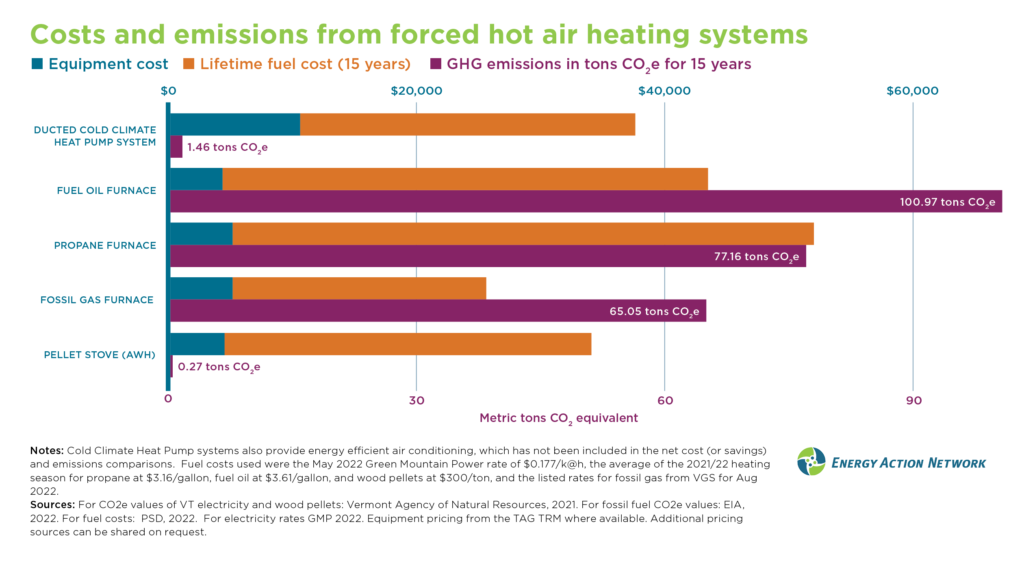
Scenario C: The Cassidy family is a lower income family who owns a small home that is well-insulated because they previously had it weatherized by the Weatherization Assistance Program. However, they still have trouble with the high cost of their propane bills. Because their home is small and well-weatherized, their heating contractor let them know that they could heat their whole home with heat pumps (while leaving their existing heating system in place as a backup). Thanks to the incentives created by the Affordable Heat Act, the Cassidy family installs the heat pumps and proceeds to save about $1,000 a year in heating costs. Scenario D: The Diaz family is a middle-income family who had a new fuel oil boiler installed 5 years ago. Because they are invested in keeping their relatively new boiler, they decide to simply switch their heating fuel from fuel oil to B99 biodiesel, made from recycled restaurant oil. Because of the Affordable Heat Act and the value of a B99 biodiesel that is 5x lower emitting than fuel oil, the cost of the biodiesel becomes lower than fuel oil. The Diaz family keeps their boiler but pays less per year in fuel than before.
Scenario E: The Edmonds family lives in an old home that is twice the size of the average home in Vermont. They decide to replace their old propane boiler, which was costing them an average of $5,000 a year, or over $50,000 in total fuel costs over the past decade. Instead, thanks to the Affordable Heat Act, the upfront cost to install a new advanced wood heating pellet boiler is brought down to less than the cost of installing another propane boiler. After installing the pellet boiler, the Edmonds family saves an average of $2,000 a year in fuel costs as a result of using wood pellets rather than propane.
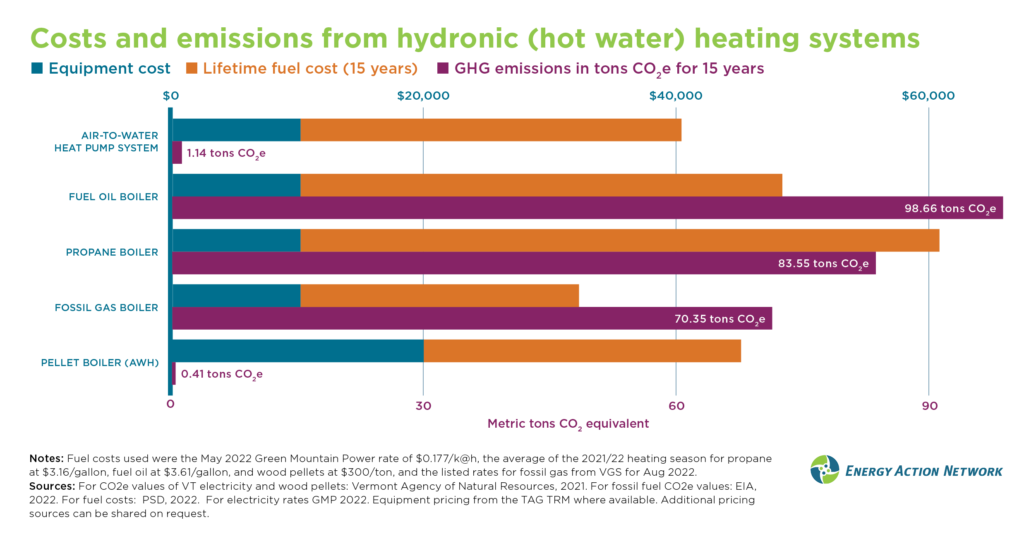
By establishing a Clean Heat Standard, the Affordable Heat Act will deliver on the # 1 recommendation of the Vermont Climate Council in terms of reducing climate pollution. This policy will achieve more than a third of Vermont’s legally required emissions reductions under the Global Warming Solutions Act by 2030. This policy is by far the biggest pollution reduction strategy in the Climate Action Plan passed by the Vermont Climate Council and will likely be the most important climate policy Vermont has ever adopted. By 2030, it will reduce climate pollution by more than twice as much as the recently adopted Advanced Clean Cars and Advanced Clean Trucks rules. The Climate Action Plan does not add up to the GHG reductions required under the GWSA without the Affordable Heat Act.
The Affordable Heat Act would establish a Clean Heat Standard in Vermont, building on the Clean Heat Standard legislation that was developed during the 2021/2022 legislative session. However, the new Affordable Heat Act goes even further to ensure affordability, including by requiring that the majority of clean heat services delivered to low and moderate income Vermonters lower energy costs long-term. The Affordable Heat Act creates a market-based solution that will provide structure, and clear benchmarks and signals that will guide fuel providers as they transition their business models to serve cleaner energy options.
No, the Clean Heat Standard cannot be implemented without another vote of the legislature. Such a vote could only occur after the Public Utility Commission (PUC) has submitted proposed rules to the legislature, which are due in January of 2025.
While the PUC will be able to issue orders upon passage of S.5 (for instance, to require fossil fuel importers to register with the PUC so that the types and volumes of fuels they are selling becomes known), the crux of the Clean Heat Standard is the annual requirements for emissions reduction. Without those requirements, there is no Clean Heat Standard to implement. And in section 6 (f)(5), S.5 is very clear that the annual requirement can only be established via rules.
Sec. 6 (f) (5)
“The final proposed rules shall contain the first set of annual required amounts for obligated parties as described in 30 V.S.A. § 8124(a)(1). The first set of annual required amounts shall only be adopted through the rulemaking process established in this section, not through an order.”
Furthermore, S.5 makes clear that rules can not be established “without specific authorization enacted by the General Assembly” in a future year. This is commonly called the “check back” provision.
§ 8131. RULEMAKING AUTHORITY
“Notwithstanding any other provision of law to the contrary, the Commission shall not file proposed rules with the Secretary of State implementing the Clean Heat Standard without specific authorization enacted by the General Assembly.”
Two key words are “notwithstanding” and “enacted.”
While there are other sections of the bill that speak to PUC rulemaking authority, section 8131 “notwithstands” those sections (i.e. takes precedence regardless of what other parts of the bill say). And as the memo from legislative counsel clearly states, “enacted” means passage through both legislative bodies and sent to the Governor to either be signed, allowed to become law without signature, or vetoed and then overridden by 2/3 majority of both bodies.
The Clean Heat Standard is a performance standard for the thermal fuels sector. It holds the corporations that import fossil heating fuels into Vermont responsible for reducing climate pollution over time, in line with Global Warming Solutions Act requirements. No. This policy is in no way, shape, or form a tax. A tax is when the government collects revenue and then decides how to spend it. No revenue is collected by the Clean Heat
Standard. Labeling it a “tax” is simply untrue.
Instead, it requires fossil fuel importers to reduce their pollution over time in a gradual, predictable way. Whether or not fossil fuel prices increase will depend on how these fuel companies choose to adapt to the performance standard, and what types of services and energy they offer their customers. Any cost of compliance associated with the Clean Heat Standard will go toward making clean heat options more accessible and affordable for Vermonters. The goal is to help more and more Vermonters – especially lower and middle income Vermonters – save money over time by reducing dependence on high cost, price volatile fossil fuels as we move to lower cost and more price-stable heating options.
Yes. Performance standards are some of the most tried and true policies to effectively and equitably reduce climate pollution across the United States. A similar program was established over a decade ago in California to reduce pollution from transportation fuels. Similar “Clean Fuels Standards” are also now underway in Oregon and Washington, and a Clean Heat Standard is in place in Colorado.
Additionally, in Vermont, performance standards like this have existed for years in the efficiency and electricity sectors, including through Efficiency Vermont and the Renewable Energy Standard (RES). What is different about the Affordable Heat Act and Clean Heat Standard is that we will finally require the corporations that import fossil heating fuels into Vermont to take similar responsibility and help their customers cut their heating costs and carbon pollution.
The Global Warming Solutions Act establishes a legal obligation for Vermont to reduce greenhouse gas pollution. This means that one of the key criteria for a policy solution has to be: can it confidently deliver emissions reductions, on schedule and as legally required? At the same time, the Climate Council wanted to ensure that policy solutions, in addition to being able to confidently achieve emissions reduction requirements, are able to do so both equitably and cost-effectively.
The two policies with the best track records of meeting these key criteria are performance standards (like the Clean Fuels Standards in Washington, Oregon, and California) and emissions caps (like the Regional Greenhouse Gas Initiative operating in the Northeast for the electric sector and the economy-wide cap and invest program known as the Western Climate Initiative program, which both California and Quebec participate in). Fuel taxes don’t have the same track record of confidently or effectively reducing emissions, and therefore were not seriously considered.
There are two main reasons:
1) Different fuels have different carbon intensities (or lifecycle GHG emissions). A flat fuel surcharge across the board on all fossil fuels would create market distortion if the charge is not actually scaled to carbon intensity and the lifecycle greenhouse gas emissions of the fuel(s). To the extent that we are legally obligated to count and reduce GHG emissions, some complexity is necessary in any kind of policy – because GHG emissions are, themselves, complex.
2) Importantly, the Global Warming Solutions Act requires that Vermont do its part to reduce greenhouse gas emissions, in line with scientific consensus, and alongside many other states, including Massachusetts, Maine, and Connecticut. Stated another way, the performance metric we are legally held to is GHG emissions reduction – not revenue raised or dollars spent. If we implemented a fuel surcharge, it would not guarantee that emissions would actually decline (and the extent of the effect on emissions would largely depend on the wisdom and effectiveness of the resulting public investments). The goal is not to raise revenue – it is to reduce climate pollution, in the most equitable and cost-effective way possible. The only policies from around the US and the world that we have found that have been proven to be able to reduce emissions with confidence are either performance standards (which is what the Clean Heat Standard is) or emissions caps. Putting a price on carbon helps you know how much money you might raise but it does not, generally speaking, confidently guarantee emissions reduction.
Another critical source of revenue that’s rolling out now are the tax credits, grants, and rebates available under the federal Inflation Reduction Act, which have the potential to bring thousands of dollars of incentives to individual Vermont households and hundreds of millions of dollars in revenue into the state to help pay for measures like weatherization, heat pumps, etc. The Affordable Heat Act would create a framework to ensure that Vermonters have the best possible chance of benefiting from those incentives.
The Inflation Reduction Act created new and expanded incentives for efficiency and clean heat. With leverage provided by the Affordable Heat Act, Vermonters will now be able to receive hundreds of millions of additional federal dollars to invest in their homes and heating systems. This is a huge additional benefit of the Affordable Heat Act.
The IRA expanded many tax credits for clean energy, efficiency, and electrification technologies like weatherization, cold climate heat pumps, heat pump water heaters, and even the electrical panel upgrades sometimes needed to accommodate that work. It also created two new programs to provide even more significant rebates and grants for low and moderate income households. Those incentives create an incredible opportunity for Vermonters, and people across the US, to make this transition to cleaner, more affordable heating options. However, the IRA alone will not ensure that Vermont will achieve its greenhouse gas
requirements in the thermal sector.
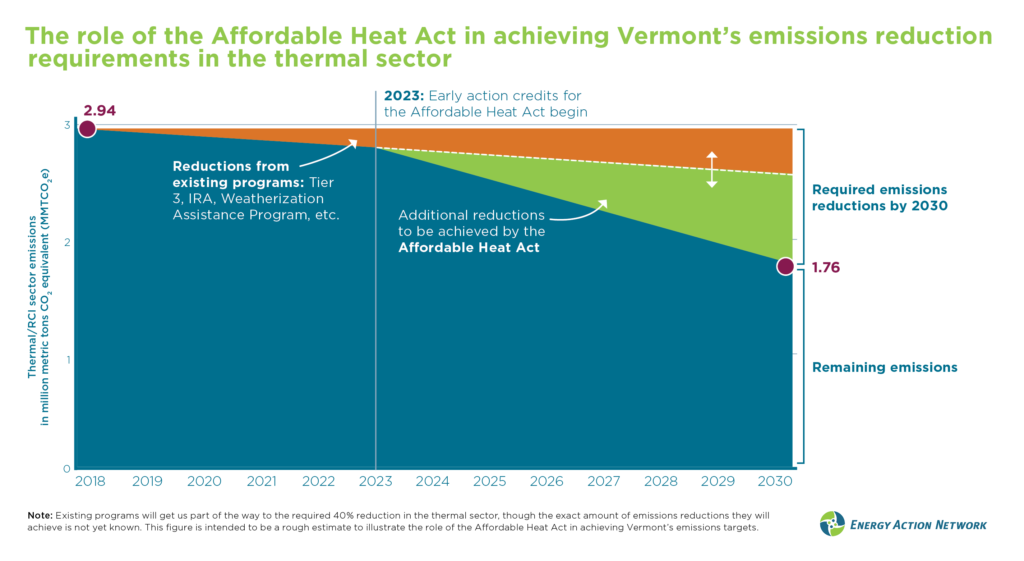
The Affordable Heat Act creates the framework to ensure exactly that. The requirement that it puts on
fossil fuel companies to help Vermonters make this transition will ensure that even more Vermont families
and businesses are able to take advantage of the incentives in the Inflation Reduction Act, ultimately resulting in hundreds of millions of dollars of additional federal funding flowing into Vermont to help pay for this work.
For more information on the incentives in the Inflation Reduction Act, check out Rewiring America’s great calculator here: https://www.rewiringamerica.org/app/ira-calculator.
A main goal of the Clean Heat Standard (CHS) is to reduce climate pollution in Vermont in line with our legal obligations – 40% lower by 2030, 80% lower by 2050.
But the CHS doesn’t have to start from scratch to do this. Vermont already has, and will likely expand, several programs that reduce both monthly energy bills and fossil heating emissions. Those programs include the Weatherization Assistance Program (WAP), fossil reductions under the Renewable Energy Standard (“Tier 3”), rebates from energy efficiency utilities, the Clean Energy Development Fund, and others. In addition, private actors, including some fuel dealers and many homeowners, schools, and businesses are taking actions on their own, perhaps with tax credits or other incentives, to insulate buildings, use biofuels, or install heat pumps or advanced wood heat systems.
All of these actions contribute towards meeting the overall emissions reduction targets of the CHS, and therefore qualify to earn clean heat credits. This is an important feature of the CHS structure that promotes cost-effective use of existing programs in the energy sector. Creating the CHS as an “umbrella” policy that counts all eligible savings the same–regardless of who delivers them–will give Vermont the greatest flexibility in reaching the GHG reduction obligations, encourage action by many actors, and will lower the cost of meeting GHG obligations.
Vermont’s existing energy-saving programs have their own internal requirements (though none have lifecycle tons of GHG reduced as their primary performance metric, as the Clean Heat Standard does), but the tons of GHG reduction they deliver are still real tons, and those tons can only be counted once for clean heat credits. The same idea applies to a private business or family who might use the tax credits now available under the Inflation Reduction Act to weatherize a building or install a heat pump. The CHS does not exclude the action just because the building owner got a tax credit for doing it. If the savings are real, they can earn clean heat credits based on the quantity of emissions reduced.
Some have asked: “But if a utility already has an obligation to deliver Tier 3 savings, or a CAP agency already has a budget to deliver low-income weatherization, isn’t it “double counting” to give the same actions credit under the CHS?”
Not at all. If an analogy helps, consider a school with a math requirement for graduation. If you take a math class it may meet the math requirement and will also count towards the credits needed to graduate. The class is satisfying two requirements, but the math credits only count once on your transcript. That’s not “double counting.”
Or consider a football game. We often say something like: “the quarterback passed for 300 yards and 2 touchdowns.” The touchdown passes are included in the 300 yards, but neither the touchdowns nor the yards are counted twice. It’s not double counting – it’s counting two different things.
Importers of fossil heating fuel into Vermont.
There is no evidence that performance standard policies create large price increases in fossil fuels. The closest example is Oregon’s Clean Fuels Standard. Oregon’s experience shows that, for every 5% reduction in emissions achieved, the effect on fossil fuel prices has only been about a 1% increase. In the worst-case scenario, for those fossil fuel suppliers in Oregon who didn’t take their own action to reduce emissions and had to buy credits from others, the cost translated to about 5-8 cents a gallon. And that money has gone directly into making clean fuel options more accessible and affordable. While there may be a price effect of some cents per gallon on fossil heating fuels, that is very minimal in comparison to the natural price swings of fossil fuels.
At the same time – and this is very important – Oregon’s policy also resulted in decreases in the prices of the cleaner alternatives.
So, while their Clean Fuel Standard had a price effect of an additional $0.05 to $0.06 per gallon of fossil fuel in 2021, in that same year it also brought down the price of biodiesel from used cooking oil by about $1.16 per gallon, and the price of biodiesel made from soybean oil by about $0.61 per gallon, making biodiesel less expensive than diesel. (Watch Senate Natural Resources and Energy hearing – 1:44:00 to 1:48:00 or read Oregon has a plan to cap emissions from fuels)
And that’s part of the goal of the Affordable Heat Act. It’s to help people pay less, saving on energy costs that have been far too high for far too long because of dependence on high cost and price volatile fossil fuels. We can’t effectively address the fact that energy costs are too high until and unless we help Vermonters reduce fossil fuel dependence by making a variety of cleaner and more affordable options more accessible.
For instance, for those fuel oil customers who currently use fuel oil and who want to save money, they will be able to use biodiesel instead, thereby lowering their heating costs (if the price of B100 biodiesel from used cooking oil or from a standard soybean biodiesel is reduced as much in Vermont as we saw in Oregon).
We should also reasonably expect the price of electricity to decline in Vermont in the near to medium term as a result of the electrification that the Affordable Heat Act will help advance, as fixed utility costs get spread over a broader base of use. This would help offset any price increase on fossil fuels. And since all Vermonters use electricity, we would all realize that benefit (whereas not all Vermonters use fossil heating).
And of course, the Affordable Heat Act is especially important in its ability to make weatherization, heat pumps, and heat pump water heaters more affordable and more accessible, giving many more options to help people escape from fuel prices that are, by their nature, high cost and price volatile.
Overall, this policy is designed to achieve massive net savings in energy costs alongside legally required pollution reduction.
Finally, the largest fossil fuel companies are some of the most profitable companies that exist right now. In 2022, while many Vermonters struggled to pay higher heating bills, Shell reaped a record profit of $40 billion in 2022 and BP raked in over $27 billion in record annual earnings. At the federal level, legislators are looking into windfall profits taxes on fossil fuel corporations and also investigating them for price gouging. Vermont can also explore ways to hold these companies responsible.
No, this statement is not true. All importers of thermal sector fossil fuels — including importers of fuel oil
and natural gas (and propane, etc.) — will be responsible for reducing their climate pollution over
time under a Clean Heat Standard. There is no exception for natural gas.
First, they won’t have to come up with all of it. This program aligns well with the ability for Vermonters to access and benefit from unprecedented financial support from federal and state programs – such as the Inflation Reduction Act (IRA), State weatherization incentives, and electric Tier 3 funds – which will offset the cost for many clean heat measures, especially those that benefit low- and moderate-income customers. Additional upfront funds could come from a fossil fuel importer’s corporate reserves, profits, or from borrowing. Fossil fuel companies, in turn, will likely seek to pass the cost of financing to their fossil fuel customers.
The obligated parties under the Clean Heat Standard are the corporations that import fossil fuel into Vermont, many of which are quite large and profitable, with significant access to capital (either held or borrowed). In 2022, two of the world’s biggest fossil fuel companies reaped record profits; with Shell recording $40 billion in profit and BP $27 billion. Closer to home, one of the largest fuel importers into Vermont is Irving Oil. The owner of Irving Oil has a net worth, as reported by Forbes Magazine, of $4 billion. There is no reason that phenomenally profitable fossil fuel corporations like Irving Oil should push their cost of complying with pollution reduction standards onto consumers – and we should explore ways to ensure that they don’t. In economics there is a principle known as “polluter pays.” It is not appropriate to keep putting the burden of investing in efficiency and clean energy solely on Vermont’s electric utilities, which are responsible for far less climate pollution than the corporations that import fossil fuel into Vermont.
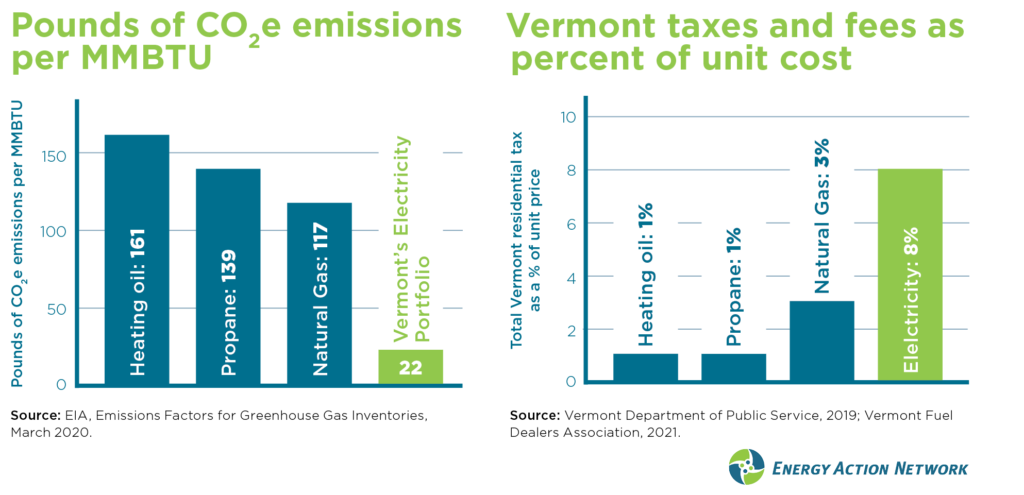
At the same time, the Affordable Heat Act will help limit the cost of compliance that fossil fuel corporations pass onto their consumers. One of the primary factors regarding the “incidence” of the cost of compliance (i.e. how much is paid by the fossil fuel corporation vs. how much is paid by the fossil fuel customer) are the relative elasticities of demand and supply. All else being equal, the more inelastic customer demand is (i.e. customers desire to buy the same volume of fuels, no matter the price), the more that fossil fuel companies can pass the cost of compliance on to their fossil fuel consumers.
However, what the AHA will do is help lower the cost and increase the accessibility of alternatives to fossil fuels (both biofuels that are actually lower emitting and installed measures like weatherization, heat pumps, heat pump water heaters, and advanced wood heat). This means that demand for fossil fuels will become more elastic, limiting the amount of the cost of compliance that a fossil fuel corporation can pass on without consumers looking for options to reduce fossil fuel use (whether through weatherization, heat pumps, advanced wood heat, or simply substituting biofuel for fossil fuel).
The obligated parties under a Clean Heat Standard are the corporations that import fossil heating fuels into Vermont. Sellers of wood are not obligated parties. Advanced Wood Heating is also explicitly named as an eligible clean heat measure. Like other clean heat measures, the extent to which wood, pellets, etc. are eligible will be determined by the Public Utility Commission (PUC) and the Technical Advisory Group (TAG) who will have to assess how many credits wood heating measures will receive, depending on a lifecycle GHG emissions analysis.
No. The Affordable Heat Act explicitly says that “Clean heat measures shall not include switching from one fossil fuel use to another fossil fuel use” (§8123 (3)).Additionally, no fossil fuels are included in the list of eligible measures (§8127 (d)). Finally, the declining carbon intensity threshold (§8127 (f)) effectively prohibits fossil fuels from generating clean heat credits because all fossil fuels have a carbon intensity above 80. For instance, in Oregon’s Clean Fuels Program, the list of Carbon Intensity Values in the Reference Materials section shows that no fossil fuel has a carbon intensity below 80.
(See Fuel Pathways – Carbon Intensity Values : Oregon Clean Fuels Program)
There are many different kinds of biofuels. Some biofuels are more polluting than fossil fuels while other biofuels are far less polluting than fossil fuels. Key factors that affect the lifecycle emissions calculations for different biofuels include the sourcing, production, and transportation of the fuel and whether/ to what extent its production resulted in direct or indirect land use change. See the chart below from Oregon’s Clean Fuels Program, which compares the lifecycle emissions of different fuels via a “carbon intensity value.” Note how different lifecycle emissions/ carbon intensities of different biofuels are.
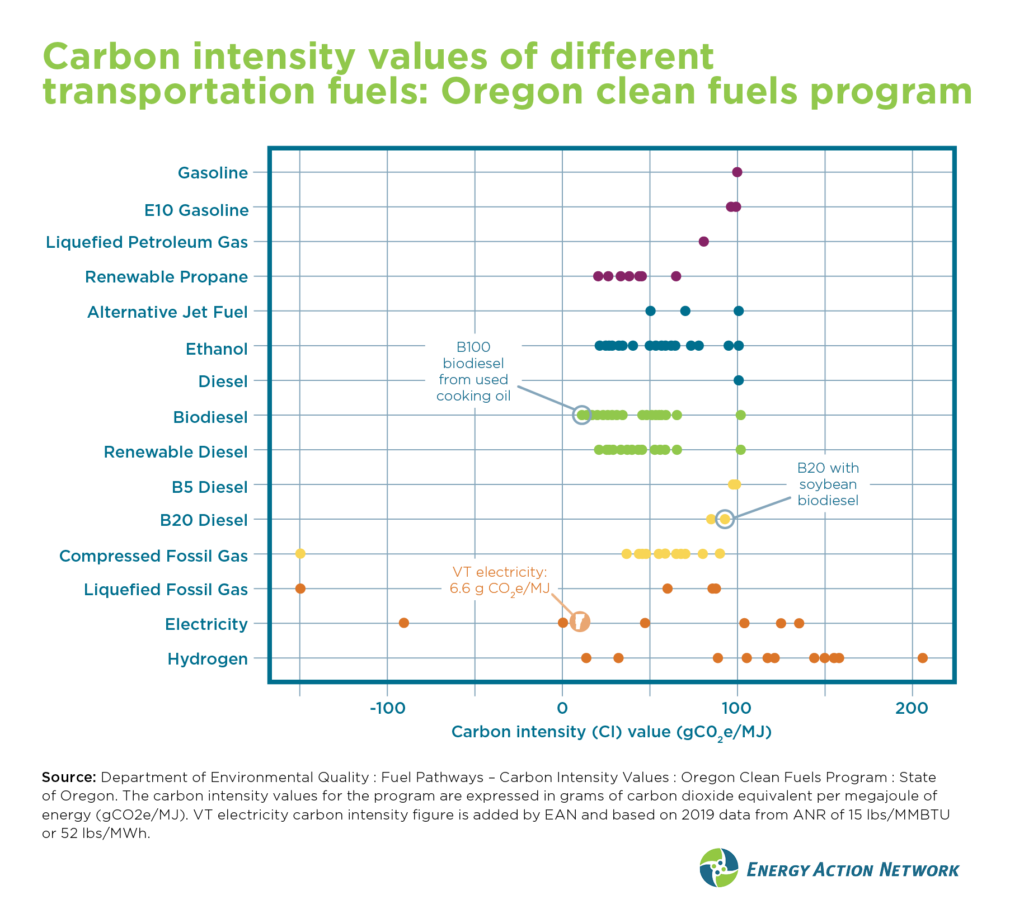
The only biofuels that will qualify for the Clean Heat Standard are those that are significantly lower emitting, as measured on a full lifecycle emissions basis, than fossil fuels. Biofuels that are more polluting than fossil fuels are ineligible for clean heat credits. For more information about biofuels, including how they are treated in related policies that informed the development of the proposed Clean Heat Standard, see this fact sheet on “Clean Fuel Standards” from the Union of Concerned Scientists.
Lifecycle greenhouse gas emissions can be understood most simply via a carbon intensity scale, with #2 fuel oil having a carbon intensity value of 100. To qualify for clean heat credits, all liquid and gaseous fuels will have to have a carbon intensity below 80 as of 2025 (or be 20% lower emitting than fuel oil), below 60 as of 2030, and below 20 as of 2050 (See: S.5 §8127 (f)). This declining carbon intensity threshold will ensure that, over time, only the lowest emitting heating solutions are eligible. Also, eligible biofuels will only receive clean heat credits in proportion to the degree that they reduce lifecycle greenhouse gas emissions. (See: S.5 §8123 (10) ;§8127 (c); §8127 (g)(2))
The Affordable Heat Act is directly tied to the Global Warming Solutions Act (GWSA). In fact, the Clean Heat Standard that the Affordable Heat Act would establish is the # 1 emission reduction policy recommendation in the Climate Action Plan that was developed by the Vermont Climate Council in order to comply with the GWSA.
The GWSA states that “Vermont shall reduce emissions of greenhouse gasses from within the geographical boundaries of the State and those emissions outside the boundaries of the State that are caused by the use of energy in Vermont” (see Act 153 §578 (a); italics added). Additionally, the use of “offsets” or “alternative reduction mechanisms” (i.e. reductions in emissions outside the boundaries of Vermont, or reductions in emissions not related to the use of energy in Vermont) are explicitly disallowed until at least 2050 (see Act 153 §593 (i)).
It’s also worth noting that most of the actions in the thermal sector that need to happen – weatherization, heat pumps, geothermal systems, etc. – need to be physically installed in Vermont buildings to benefit Vermonters, whereas cleaning up our interconnected regional electric grid can be beneficial to Vermont whether the new clean electricity is constructed within our borders or elsewhere.
Analysis done by the Vermont Climate Council and the Energy Action Network shows that we almost certainly cannot meet Vermont’s emissions reduction requirements — especially by 2030 — with weatherization and heat pumps alone. Challenges include a) the number of fossil fuel heating systems that currently exist in Vermont homes and buildings; b) the age of Vermont’s housing and building stock, and c) limited workforce. Let’s take each of these in turn:
a) The number of fossil fuel heating systems that currently exist in Vermont homes and buildings
Currently, the leading source of space heating in VT homes is fuel oil boilers and furnaces. Specifically, 43% of Vermont households report that fuel oil is their primary heating source (compared to only 5% nationally). After fuel oil, other primary heating sources for Vermont homes include fossil gas (17.5%), wood (16.5%), and propane (16%).
A challenge is that the fuel oil, propane, or fossil gas boilers and furnaces that use these fuels often operate for 20 years or more — so there are fewer opportunities to replace them than there are with shorter-lived equipment. And as long as these pieces of equipment exist in the basements of Vermonters and continue to be in use, they will either use fossil fuel or a biofuel.
The Clean Heat Standard would incentivize Vermonters to use those biofuels that are cleaner than fossil fuels for as long as those pieces of equipment continue to be in operation. Even when a residence or business adds heat pumps, in a cold climate like ours where winter temperatures are frequently below zero, keeping a backup source of heat is often important for safety, reliability, and resilience — and the Clean Heat Standard would help incentivize the fuels that those backup or supplemental options use to be as clean as possible. (Vermont Housing Needs Assessment: 2020-2024 p. 31)
b) The age of Vermont’s housing and building stock
Vermont’s housing is older than the national average. The median home in Vermont was built nearly half a century ago (1974) and over a quarter of our homes were built before 1939. Less than a quarter of Vermont homes have been built since 1990. This means that many Vermont homes are not very energy efficient, leading to higher than necessary energy costs.
Vermont has the challenge — and the opportunity — to weatherize a lot of our homes and buildings as soon as possible, especially if we want to be able to make greater use of heat pump technology. However, there is a limited workforce currently available to do this work at scale. Currently Vermont is weatherizing only about 2,000 homes/ year. To help meet climate and affordability goals, Climate Council analysis suggests we should be comprehensively weatherizing closer to 10,000 homes/year — but we don’t yet have the workers to do so. (Vermont Housing Needs Assessment: 2020-2024 p. 32)
c) Limited workforce
While weatherization and the installation of cleaner heat systems like heat pumps and advanced wood heat can cut costs and pollution, they are also labor-intensive activities that require available workforce to do the projects. To the extent that we face workforce limitations, having less labor-intensive options – such as simply switching to using less polluting fuels – is an important option to have on the table if we are to ensure that we can meet our emissions reduction obligations, especially for 2030, cost-effectively in the face of workforce shortages.
Modern cold climate heat pumps have been proven to work very well in Vermont. They can operate efficiently and effectively when the outside temperature is below zero, and provide substantial heat to Vermont homes all winter. Older models could not, and unfortunately some units that can only operate to around 0 degrees are still being installed. Efficient electric heat pumps should be a big part of cutting costs and cutting greenhouse gas pollution in Vermont, but they’re not a silver bullet. Many households installing heat pumps also weatherize, and most continue to use other fuels as well. That’s what the Affordable Heat Act and a Clean Heat Standard will continue to allow — a variety of options, based on Vermonters preferences and unique circumstances.
It’s also true that no matter what your primary heating system is, it is best to have backup heating options. Many Vermonters who heat with heat pumps have backup of supplemental heat provided by wood heating options, or by their existing furnaces or boilers, whether those are fueled by fossil fuels or biofuels.
It’s also important to note that the Affordable Heat Act and the Clean Heat Standard that it would establish does not require heat pumps (or any technology). It simply makes heat pumps a more attractive option – alongside many other solutions that are cleaner than fossil fuels, from efficient wood heating to those biofuels that are significantly lower-emitting than fossil fuels, in addition to weatherization — which reduces energy use no matter how a home or building is heated.
No, this is not true. First, the Affordable Heat Act does not require any Vermonter to change their heating system – the law only requires fossil importers to help provide Vermonters with more and better choices. And cold climate heat pumps are only one of many options that will qualify for clean heat credits and become more available and affordable to Vermonters as a result of the Affordable Heat Act. Other options include: weatherization; advanced wood heat; sustainable biofuels, and more.
See: S.5 §8127 (d) (1-12)
Thanks in large part to the great work done on electric efficiency by efficiency utilities Efficiency Vermont and Burlington Electric Department and because of new, in-state distributed renewable electricity generation, a significant amount of headroom for additional load currently exists in our electric transmission and distribution system. This means Vermont can accommodate widespread beneficial electrification while saving all ratepayers money.
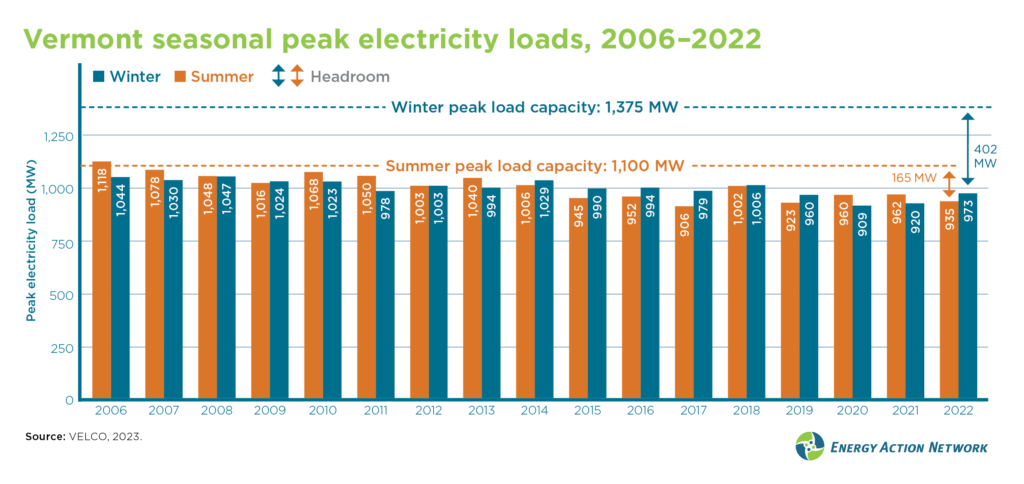
The Vermont Electric Power Company (VELCO) reports that our transmission system is already capable of serving, conservatively, a peak load of about 1,100 megawatts (MW) in the summer, and is predicted to be capable of serving, again conservatively, about 1,375 MW in the winter. This approximately 25% higher winter peak load capacity arises because transmission is much more efficient at lower temperatures, and is good news for electrification in the heating sector.
The 2021 Vermont Long-Range Transmission Plan found minimal impacts to distribution transformers in the high load scenario at a summer peak of 1,209 MW and a winter peak of 1,471 MW. However, unlike in summer, the distribution system remains largely untested at high loads in winter.
VELCO reports that our current transmission system is capable of handling high levels of electrification through 2030 (though relatively smaller scale upgrades at certain points on the distribution system will be necessary, and increased use of load flexibility may be needed). VELCO’s 2021 Vermont Long-Range Transmission Plan specifically states that even when modeling a “high load” scenario through 2030 we are “able to address transmission concerns.”
Beyond 2030, VELCO projects the heavy use of load management (for example, not charging EVs at periods of peak demand) and adjustments in tie-line flows as being increasingly necessary to accommodate high loads.
First, only corporations that import fossil fuel into Vermont are obligated to comply with the Clean Heat Standard. Fuel dealers that do not import fossil fuels into Vermont (but instead buy their fuel from Vermont-based wholesalers) do not have to acquire clean heat credits.
Additionally, many fuel dealers will be able to expand thanks to a Clean Heat Standard. The Clean Heat Standard will incentivize many fuel dealers to diversify their business and provide clean heat services to their customers. Many fuel dealers are already transitioning away from exclusively selling fossil fuels, expanding as “energy service providers,” with a full complement of weatherization services, deploying heat pumps, selling wood pellets, and selling biofuels. Examples include VGS, Bourne’s Energy, and the Energy Co-op of Vermont. The Stone age didn’t end because we ran out of stones: this is an opportunity to better serve customers with lower-cost and more price-stable heating options and to innovate and grow local businesses as we meet our social and environmental responsibility to move beyond fossil fuel dependence.
There are two main reasons.
Regarding a more equitable energy transition, it is important to note that most of the clean heat installations that are already occurring tend to be installed by Vermonters with the financial means to invest in adding to or changing their heating systems.
If we want to make sure that the transition to cleaner and more affordable heat is an equitable one where Vermonters with lower and moderate incomes can also benefit from the transition away from high-cost and price-volatile fossil fuels like fuel oil and propane, then we need to require that those Vermonters with lower and moderate incomes be served, because they often need more of the up-front cost covered.
The second reason is that just generating some amount of clean heat activity is not the goal. What we are obligated to do is to shift the market to ensure that the required scale and pace of emissions reduction occurs, in line with our legal obligations under the Global Warming Solutions Act. Without this policy, a business-as-usual approach is likely to lead to far less clean heat activity overall and far fewer clean heat services provided to Vermonters with lower and moderate incomes, in particular.
The Affordable Heat Act is an accountability mechanism to ensure that this transition actually happens at the scale and pace necessary to deliver maximum to achieve Global Warming Solutions Act obligations in the thermal sector and that, while we do so, Vermonters with lower and moderate incomes receive a progressive share of the benefits of that transition. If fossil fuel companies are correct that all of this activity would happen anyway, then it will be very easy for them to acquire clean heat credits without having to pay anything extra to incentivize that additional activity. In that case, the cost to fossil fuel importers to acquire clean heat credits will be at or near $0 and the cost of compliance with this program will be minimal.
No state, no country alone can solve the climate crisis. We all have to do our part. Reducing
our own greenhouse gas pollution – which we create and have the ability to reduce – is our
part. Vermont’s per capita greenhouse gas emissions are the second highest in the Northeast
and are much higher, both currently and historically, than those of other people around the
world.
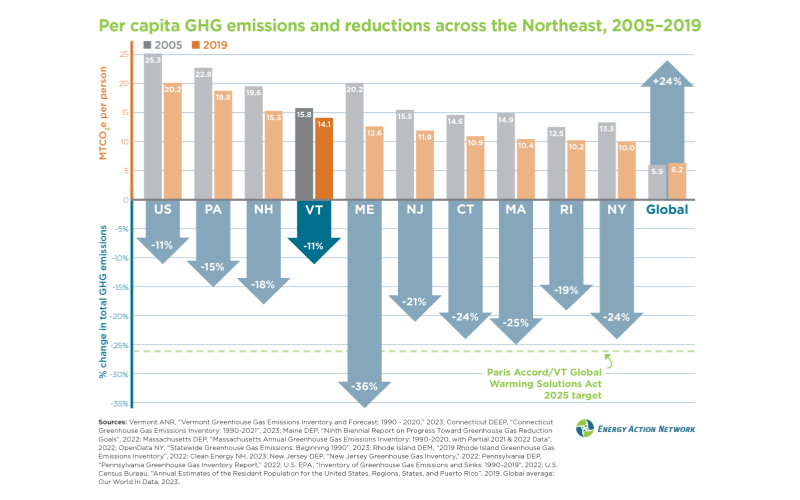
Vermonters are not the type to shirk responsibility – or miss an opportunity to make life better for their neighbors. Every state, country, nation doing “their part” is how we will impact global climate change. And here, in Vermont we can do that while also reducing the cost of heating.
Vermonters will continue to be exposed to high cost and price volatile fossil fuels without a plan to reduce fossil fuel dependence and costs from heating. It will also be next to impossible to meet our legally (and morally) binding requirements to reduce Vermont’s climate pollution.
Without the Affordable Heat Act and the Clean Heat Standard — the #1 pollution reduction strategy recommended by the Vermont Climate Council — the Climate Action Plan simply does not add up. In that scenario, Vermont will likely be put under court order to meet our emissions reduction requirements — but with less time, less flexibility, and at greater cost.
The worst possible scenario for Vermonters is for our state government to continue to do nothing with regard to heating sector policy and holding fossil fuel companies accountable. We’ve seen the price of oil spike over and over again due to forces outside of our control – often due to decisions made by dictators and autocrats like Vladimir Putin. The fossil fuels we primarily heat with in Vermont – every drop of which we import – are tied to global markets. That reality leaves Vermonters incredibly exposed and vulnerable. The only way we can truly insulate Vermonters from the oil price volatility that will inevitably keep happening in the future is to move away from those fuels to more affordable, price-stable, predictable options. At this
particularly hard and tenuous time in Vermont and across the world, looking back, the best time to have passed this policy would’ve been a decade ago. The best time today is now.